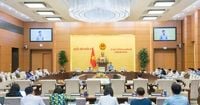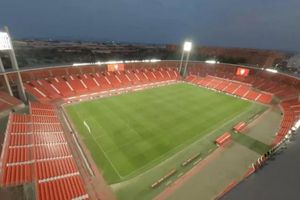At the recent 20th Conference, the Hanoi Party Committee Executive Committee reviewed and reached a consensus on the Project concerning the arrangement of administrative units and the organization of the city's political system apparatus. Deputy Chairman of the Hanoi People's Committee, Le Hong Son, noted that based on the Central Government's orientation, the city proposed maintaining the current structure of local government at the provincial level, in accordance with the provisions of the Capital Law set to take effect in 2024.
The grassroots-level People's Council agency is structured to include a Chairman of the People's Council (who also holds another position) and a full-time Vice Chairman. Additionally, the grassroots-level elected agency consists of two committees: Legal and Economic-Social, each led by a head (who concurrently holds another position) and a full-time vice head.
The grassroots-level People's Committee agency includes a full-time Chairman and two Vice Chairmen. One Vice Chairman concurrently serves as the Chief of the People's Council and People's Committee Office, while the other Vice Chairman takes on the role of Director of the Public Administrative Service Center. Following guidance from the Central Steering Committee, the commune-level People's Committee will have four specialized departments: the People's Council and People's Committee Office; Economic Department (for communes) or Economic, Infrastructure and Urban Department (for wards); Culture-Social Department; and the Public Administrative Service Center.
Regarding staffing, Deputy Chairman Le Hong Son emphasized that initially, the city would utilize the existing staffing levels of the district and commune levels to assign personnel to the new commune-level administrative units, implementing arrangements as directed by the Central Government. Besides the staffing target assigned by the Central Government (approximately 32 personnel per commune and ward, excluding Party and union members), the city will propose that the Central Government allow a K coefficient ranging from 1.5 to 2 times, calculated based on population size and socio-economic characteristics, to ensure effective task execution.
The proposed K coefficient arises from expectations that, post-arrangement, Hanoi will reduce its administrative units from 526 to 126 (comprising 73 communes and 53 wards). Notably, four units will have populations exceeding 100,000: Xuan Phuong (nearly 109,000), Phu Dong (over 117,000), Dong Anh (over 116,000), and Hong Ha (126,000). Currently, Hoang Liet ward in Hoang Mai district has a population nearing 100,000, leading to challenges in local governance and infrastructure strain.
In the education sector, the city will maintain existing public secondary, primary, and kindergarten schools, transferring their management to the commune level. The vocational education and continuing education center under the district-level People's Committee will be reassigned to the Department of Education and Training for better service provision across inter-commune and ward areas.
In health services, the city intends to keep the current commune and ward health stations. Following the administrative arrangement, these health stations will be reorganized to operate directly under the commune-level People's Committee, ensuring proper service delivery. The health centers and general hospitals currently under the district-level People's Committee will also be transferred to the Department of Health for streamlined service provision across inter-commune and ward areas.
Furthermore, the city plans to establish a public service unit directly under the commune-level People's Committee, fully funded by the state, to provide essential public services in areas such as culture, sports, tourism, information, communication, agriculture, and the environment. Additionally, a self-financed public service unit will be created to manage public services related to investment project management, land development, site clearance, park management, green spaces, cemeteries, and urban infrastructure.
As for villages and residential groups, the city will maintain the current structure. After the administrative units at all levels are arranged, Hanoi will evaluate and establish a roadmap to reorganize villages and residential groups in a streamlined manner, directly benefitting community life.
Recently, Chairman of the Hanoi People's Committee, Tran Sy Thanh, issued a document to the People's Committees of districts, towns, and cities regarding the arrangement plan for commune-level administrative units. Currently, Hanoi has 526 communes and wards, and the proposed arrangement aims to reduce this number to 126, facilitating a more efficient governance structure.
Hanoi spans a total area of 3,359.84 km², comprising 30 district-level administrative units (12 districts, 1 town, and 17 districts) and 526 commune-level administrative units (160 wards, 21 towns, and 345 communes). The city's regular and temporary population exceeds 8.5 million people, with the twelve central districts covering 308.04 km², accounting for 9.19% of the city's total area and housing 3,480,893 residents, or 42% of the city's total population.
In related developments, during the 44th Session of the National Assembly, Vice Chairman Nguyen Khac Dinh led discussions on the draft Law amending and supplementing several articles of the Law on the Vietnam Fatherland Front, the Law on Trade Unions, the Law on Youth, and the Law on Implementation of Democracy at the grassroots level. Vice Chairman and Secretary General of the Central Committee of the Vietnam Fatherland Front, Nguyen Thi Thu Ha, presented a summary of the draft, emphasizing its focus on the organizational structure and operational principles of the Vietnam Fatherland Front and related socio-political organizations.
The draft Law comprises five articles aimed at amending and supplementing key provisions to ensure alignment with the 2013 Constitution and to provide a legal framework for the reorganization of the Vietnam Fatherland Front as per the Central Executive Committee's approved Project. The Central Committee also proposed expediting the drafting and promulgation processes.
Chairman of the Committee for Culture and Society, Nguyen Dac Vinh, noted that the Standing Committee supported the necessity of enacting this Law to realize the Party's policies on reorganizing the political system, addressing overlaps and duplications in functions and responsibilities following the arrangement.
In conclusion, the National Assembly Standing Committee urged the drafting agency to incorporate feedback from the session and finalize the draft Law for submission to the National Assembly for comments ahead of the upcoming 9th Session. This process underscores the commitment to ensuring that the legal framework remains coherent, compliant, and responsive to both domestic and international standards.




